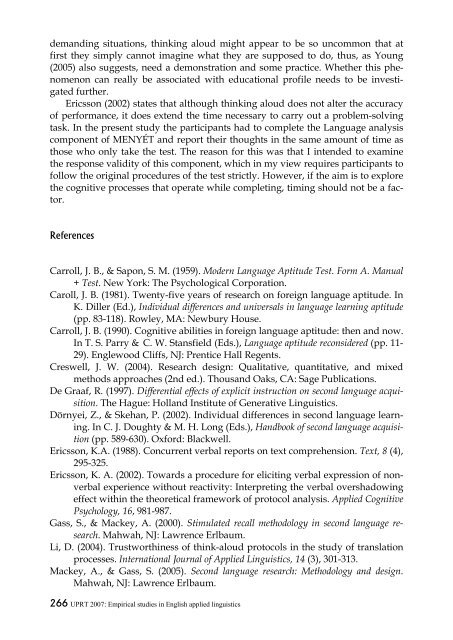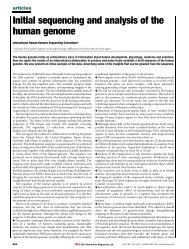Investigating a Hungarian Language Learning Aptitude Test with ...
Investigating a Hungarian Language Learning Aptitude Test with ...
Investigating a Hungarian Language Learning Aptitude Test with ...
Create successful ePaper yourself
Turn your PDF publications into a flip-book with our unique Google optimized e-Paper software.
demanding situations, thinking aloud might appear to be so uncommon that atfirst they simply cannot imagine what they are supposed to do, thus, as Young(2005) also suggests, need a demonstration and some practice. Whether this phenomenoncan really be associated <strong>with</strong> educational profile needs to be investigatedfurther.Ericsson (2002) states that although thinking aloud does not alter the accuracyof performance, it does extend the time necessary to carry out a problem-solvingtask. In the present study the participants had to complete the <strong>Language</strong> analysiscomponent of MENYÉT and report their thoughts in the same amount of time asthose who only take the test. The reason for this was that I intended to examinethe response validity of this component, which in my view requires participants tofollow the original procedures of the test strictly. However, if the aim is to explorethe cognitive processes that operate while completing, timing should not be a factor.ReferencesCarroll, J. B., & Sapon, S. M. (1959). Modern <strong>Language</strong> <strong>Aptitude</strong> <strong>Test</strong>. Form A. Manual+ <strong>Test</strong>. New York: The Psychological Corporation.Caroll, J. B. (1981). Twenty-five years of research on foreign language aptitude. InK. Diller (Ed.), Individual differences and universals in language learning aptitude(pp. 83-118). Rowley, MA: Newbury House.Carroll, J. B. (1990). Cognitive abilities in foreign language aptitude: then and now.In T. S. Parry & C. W. Stansfield (Eds.), <strong>Language</strong> aptitude reconsidered (pp. 11-29). Englewood Cliffs, NJ: Prentice Hall Regents.Creswell, J. W. (2004). Research design: Qualitative, quantitative, and mixedmethods approaches (2nd ed.). Thousand Oaks, CA: Sage Publications.De Graaf, R. (1997). Differential effects of explicit instruction on second language acquisition.The Hague: Holland Institute of Generative Linguistics.Dörnyei, Z., & Skehan, P. (2002). Individual differences in second language learning.In C. J. Doughty & M. H. Long (Eds.), Handbook of second language acquisition(pp. 589-630). Oxford: Blackwell.Ericsson, K.A. (1988). Concurrent verbal reports on text comprehension. Text, 8 (4),295-325.Ericsson, K. A. (2002). Towards a procedure for eliciting verbal expression of nonverbalexperience <strong>with</strong>out reactivity: Interpreting the verbal overshadowingeffect <strong>with</strong>in the theoretical framework of protocol analysis. Applied CognitivePsychology, 16, 981-987.Gass, S., & Mackey, A. (2000). Stimulated recall methodology in second language research.Mahwah, NJ: Lawrence Erlbaum.Li, D. (2004). Trustworthiness of think-aloud protocols in the study of translationprocesses. International Journal of Applied Linguistics, 14 (3), 301-313.Mackey, A., & Gass, S. (2005). Second language research: Methodology and design.Mahwah, NJ: Lawrence Erlbaum.266 UPRT 2007: Empirical studies in English applied linguistics
















